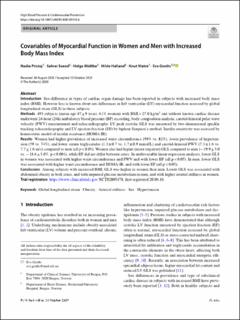| dc.contributor.author | Pristaj, Nadia | |
| dc.contributor.author | Saeed, Sahrai | |
| dc.contributor.author | Midtbø, Helga Bergljot | |
| dc.contributor.author | Halland, Hilde | |
| dc.contributor.author | Matre, Knut | |
| dc.contributor.author | Gerdts, Eva | |
| dc.date.accessioned | 2021-05-20T08:27:27Z | |
| dc.date.available | 2021-05-20T08:27:27Z | |
| dc.date.created | 2020-11-09T12:35:44Z | |
| dc.date.issued | 2020 | |
| dc.Published | High Blood Pressure & Cardiovascular Prevention. 2020, 1-8. | |
| dc.identifier.issn | 1120-9879 | |
| dc.identifier.uri | https://hdl.handle.net/11250/2755790 | |
| dc.description.abstract | Introduction
Sex-difference in types of cardiac organ damage has been reported in subjects with increased body mass index (BMI). However less is known about sex-differences in left ventricular (LV) myocardial function assessed by global longitudinal strain (GLS) in these subjects.
Methods
493 subjects (mean age 47 ± 9 years, 61% women) with BMI > 27.0 kg/m2 and without known cardiac disease underwent 24-hour (24h) ambulatory blood pressure (BP) recording, body composition analysis, carotid-femoral pulse wave velocity (PWV) measurement and echocardiography. LV peak systolic GLS was measured by two-dimensional speckle tracking echocardiography and LV ejection fraction (EF) by biplane Simpson’s method. Insulin sensitivity was assessed by homeostatic model of insulin resistance (HOMA-IR).
Results
Women had higher prevalence of increased waist circumference (99% vs. 82%), lower prevalence of hypertension (59 vs. 74%), and lower serum triglycerides (1.3 ± 0.7 vs. 1.7 ± 0.9 mmol/L) and carotid-femoral PWV (7.3 ± 1.6 vs. 7.7 ± 1.6 m/s) compared to men (all p < 0.05). Women also had higher (more negative) GLS compared to men (− 19.9 ± 3.0 vs. − 18.6 ± 3.0%, p < 0.001), while EF did not differ between sexes. In multivariable linear regression analyses, lower GLS in women was associated with higher waist circumference and PWV and with lower EF (all p < 0.05). In men, lower GLS was associated with higher waist circumference and HOMA-IR, and with lower EF (all p < 0.05).
Conclusions
Among subjects with increased BMI, GLS was higher in women than men. Lower GLS was associated with abdominal obesity in both sexes, and with impaired glucose metabolism in men, and with higher arterial stiffness in women. | en_US |
| dc.language.iso | eng | en_US |
| dc.publisher | Springer | en_US |
| dc.rights | Navngivelse-Ikkekommersiell 4.0 Internasjonal | * |
| dc.rights.uri | http://creativecommons.org/licenses/by-nc/4.0/deed.no | * |
| dc.title | Covariables of Myocardial Function in Women and Men with Increased Body Mass Index | en_US |
| dc.type | Journal article | en_US |
| dc.type | Peer reviewed | en_US |
| dc.description.version | publishedVersion | en_US |
| dc.rights.holder | Copyright The Author(s) 2020 | en_US |
| cristin.ispublished | true | |
| cristin.fulltext | original | |
| cristin.qualitycode | 1 | |
| dc.identifier.doi | 10.1007/s40292-020-00418-6 | |
| dc.identifier.cristin | 1846126 | |
| dc.source.journal | High Blood Pressure & Cardiovascular Prevention | en_US |
| dc.source.pagenumber | 579-586 | en_US |
| dc.identifier.citation | High Blood Pressure & Cardiovascular Prevention. 2020, 27, 579-586. | en_US |
| dc.source.volume | 27 | en_US |

